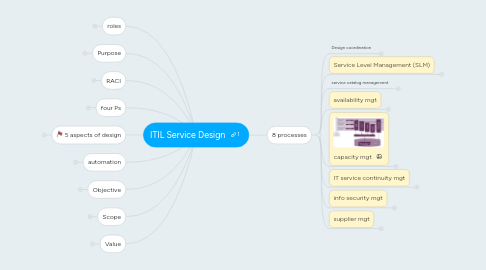
1. 8 processes
1.1. Design coordination
1.1.1. SDP
1.1.1.1. service design package
1.1.1.1.1. handoff to service transition
1.1.1.1.2. guidelines for building
1.1.1.1.3. testing
1.1.1.1.4. deploying maintaining
1.1.1.2. contains
1.1.1.2.1. requirements
1.1.1.2.2. service design
1.1.1.2.3. organisational readiness
1.1.1.2.4. service lifecycle plan
1.1.2. only applies to service design
1.1.3. objectives
1.1.3.1. plan resources
1.1.3.2. 5 aspects of design
1.1.3.3. ensure Service Models are ok
1.1.3.3.1. pictorial rep of service
1.1.3.4. monitor and improve performance of service design
1.1.4. scope
1.2. Service Level Management (SLM)
1.2.1. negotiate SLAs with customer
1.2.1.1. define and document SLAs
1.2.1.2. negotiate of warranty
1.2.2. agreements
1.2.2.1. SLA
1.2.2.1.1. IT provider and customer
1.2.2.1.2. Service based
1.2.2.1.3. Customer based
1.2.2.1.4. Multi-level
1.2.2.2. OLA
1.2.2.2.1. IT provider and another BU
1.2.2.2.2. in support of an SLA
1.2.2.3. contract
1.2.2.3.1. MANAGED BY SUPPLIER MANAGEMENT
1.2.2.3.2. Underpinning Contracts
1.2.2.3.3. for 3rd parties
1.2.3. Service Improvement Plan
1.2.3.1. tool for identifying opportunity for improvement of services
1.2.3.2. key link between SL management process
1.2.4. Service Review
1.2.4.1. review achievements
1.2.4.2. identify weaknesses
1.2.5. SLA monitoring
1.2.5.1. SLAM
1.2.5.1.1. chart
1.2.5.1.2. target met, breached, threatened
1.2.6. concerned with warranty of service
1.2.6.1. continuity
1.2.6.2. service
1.2.6.3. availability
1.2.6.4. capacity
1.2.6.5. relies on accuracy
1.2.6.5.1. Service Portfolio
1.2.6.5.2. Service Catalog
1.3. service catalog management
1.3.1. dev & maintenance of service and SP descriptions
1.3.2. consistency betw the service catalogue and the CMS
1.3.3. contribute to definition of services & service packages
1.3.4. excludes
1.3.4.1. fulfillment of service requests
1.3.4.2. mgt of risks
1.4. availability mgt
1.4.1. measured by
1.4.1.1. availability
1.4.1.2. reliability
1.4.1.2.1. mean time between service incidents
1.4.1.3. serviceability
1.4.1.3.1. degree to which have back ups or service agreements for your components
1.4.1.4. maintainability
1.4.1.4.1. mean time repair
1.4.1.4.2. mean time to restore a service
1.4.2. prioritize
1.4.2.1. VITAL BUSINESS FUNCTION
1.4.2.1.1. determined by the business
1.4.3. mgt
1.4.3.1. focal point for all availability and performance issues of services and resources
1.4.3.2. ensure availability of IT to meet requirements in cost effective manner
1.4.3.3. includes SM infrastructure
1.4.3.3.1. e.g. service desk
1.4.4. build availability into design
1.4.5. objectives
1.4.5.1. availability plan
1.4.5.2. guidance on availability
1.4.5.3. impact of changes on availability
1.4.5.4. improve service performance
1.4.5.5. manage services and resource related to delivering availability
1.4.6. risks inherent in infrastructure
1.4.6.1. tend to be localised to a specific service
1.4.6.2. short duration
1.5. capacity mgt
1.5.1. capacity to deliver services at promise
1.5.2. without access capacity
1.5.3. focal point for capacity & performance issues of services and resources
1.5.4. ensure capacity of IT services and infrastructure
1.5.5. sub-processes
1.5.5.1. Business capacity mgt
1.5.5.1.1. strategic
1.5.5.2. Service capacity mgt
1.5.5.2.1. tactical
1.5.5.3. Component capacity mgt
1.5.5.3.1. volumes transactions & response times
1.5.5.3.2. relation betw service demand & component demand
1.5.5.3.3. operational
1.5.6. normally capacity is not involved in HR except when lack of adequate HR can result in inability to meet service agreements.
1.5.7. overlap between this and availability
1.5.8. objectives
1.5.8.1. capacity plan
1.5.8.2. guidance
1.5.8.3. assess impact changes
1.5.8.4. improvements to service performance
1.5.8.5. tech changes that affect capacity
1.5.9. scope
1.5.9.1. short to long term requirements
1.5.9.2. all tech
1.5.9.3. HR capacity (people)
1.5.9.4. PBA
1.5.9.5. Demand Management
1.5.9.6. updates to business plans
1.5.10. activities
1.5.10.1. iterative
1.5.10.1.1. monitoring
1.5.10.1.2. analysing
1.5.10.1.3. and...
1.5.10.2. demand
1.5.10.2.1. short term problems with capacity
1.5.10.3. modelling
1.5.10.3.1. tactical & operational
1.5.10.4. application sizing
1.5.10.4.1. tactical & operational
1.5.10.5. storage of capacity mgt data
1.5.10.5.1. CMIS
1.6. IT service continuity mgt
1.6.1. external threats fires, floods, terrorism
1.6.2. long duration
1.6.3. cannot exist in IT vacuum
1.6.3.1. closely aligned with business continuity mgt
1.6.4. focus on
1.6.4.1. data loss
1.6.4.2. internal or external IT systems
1.6.4.3. network services
1.6.4.4. key tech /support staff availability
1.6.4.5. service providers failure
1.6.5. objectives
1.6.5.1. support overall business continuity
1.6.5.2. BUSINESS IMPACT ANALYSIS
1.6.5.2.1. impact of loss of service
1.6.5.2.2. do regularly
1.6.5.3. maintain IT service continuity plans
1.6.5.4. assess changes
1.6.5.5. preparation for disasters as defined by the business
1.6.5.6. work with supplier mgt to negotiate contracts
1.6.6. scope
1.6.6.1. exc
1.6.6.1.1. business risks
1.6.6.1.2. minor tech faults
1.7. info security mgt
1.7.1. confidentiality
1.7.2. integrity
1.7.3. availability
1.7.4. authenticity & non-repudiation
1.7.5. INFORMATION SECURITY POLICY
1.7.5.1. dev info security mgt
1.7.5.2. available to everyone involved with IT services
1.7.6. SMIS
1.7.6.1. security mgt info system
1.7.6.1.1. info security policy
1.7.6.1.2. security reports & info
1.7.6.1.3. security controls
1.7.6.1.4. security risks & responses
1.7.7. tactical process
1.7.7.1. related to access mgt
1.7.7.2. within corp gov
1.7.7.3. aligned bus security
1.7.8. SCOPE
1.7.8.1. protection of components
1.8. supplier mgt
1.8.1. underpinning contracts
1.8.1.1. basic terms & conditions
1.8.1.2. service desc & scope
1.8.1.3. service standards
1.8.1.4. workload ranges
1.8.1.5. mgt info
1.8.1.6. resp & dependencies
1.8.2. relationships
1.8.2.1. strategic
1.8.2.2. tactical
1.8.2.3. operational
1.8.2.4. commodity
2. Objective
2.1. designing warranty into service
3. Scope
3.1. new or change services
3.2. and Service Management
4. Value
4.1. Reduce TCO
4.2. Improve quality of service
4.3. improve consistency of service
4.4. ease implementation of new or change services
4.5. improve service alignment
4.6. improve service performance
5. automation
5.1. hardware design tools
6. 5 aspects of design
6.1. process
6.1.1. control
6.1.2. enablers
6.2. information systems & tools
6.3. service solutions
6.4. architectures
6.4.1. infrastructure
6.4.2. technology
6.4.2.1. application systems
6.4.2.2. databases
6.4.2.3. infrastructure design
6.4.2.4. monitoring systems
6.4.3. management
6.4.3.1. best of breed
6.4.3.1.1. multiple suppliers
6.4.3.2. proprietary
6.4.3.2.1. single source
6.5. metrics
6.5.1. progress
6.5.2. compliance
6.5.3. effectiveness
6.5.4. efficiency
7. four Ps
7.1. People
7.2. Processes
7.3. Products/technology
7.4. Partner/suppliers
8. RACI
8.1. no more than 1 person accountable
8.2. delegate resp or auth without necessary authority
8.3. roles and responsbilities
9. Purpose
9.1. design services, with governing practices, processes and policies
9.1.1. to realise providers strategy
9.1.2. facilitate intro of the services
10. roles
10.1. process owner
10.1.1. accountable
10.2. service owner
10.2.1. accountable
